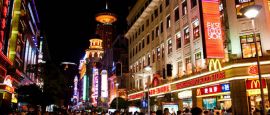Lined with European colonial-era architecture, the former French Concession is a great place to wander aimlessly and typifies Shanghai's international sophistication and style. Particular gems include the grounds of the Ruijin Guest House, 118 Ruijin Er Lu (formerly the Morris Estate), complete with a variety of restaurants, and the art galleries, designer boutiques and cafés of Tianzifang (also known as Taikang Lu). Fuxing Park has shady walks and there are many delightful old residences along Sinan Lu (including some belonging to revolutionaries Sun Yatsen and Zhou Enlai).
Things to see in Shanghai
Tourist offices
Address: No 2, Alley 123, Xingye Road, Xintiandi, Huangpu, Shanghai, 200000, China
Tel: +86 21 6384 9366.
Opening Hours:
Mon-Sun 1000-2200.
en.shio.gov.cn/resource/services/services-center.htmlWith over 300 publications on what to do in Shanghai, and staff armed with knowledge on the latest trends in China’s most futuristic city, the SHIO is the best place to head when you need advice.
Once the site of the Shanghai Racecourse, People’s Square is the modern city’s nerve centre. Overshadowed by the dramatic form of the Tomorrow Square skyscraper, this open space is peppered with museums, performing arts venues and leafy People’s Park. Beneath it all, the city’s frenetic energy reaches full crescendo amid the tunnels of Shanghai’s busiest subway interchange.
Shanghai's most popular tourist attraction, and unmistakeable the symbol of the city's colonial past, the Bund features a 1.6km (1-mile) strip of historic riverfront buildings, separated from the Huangpu River by a raised terrace embankment. Buildings include Customs House (with its famous bell ‘Big Ching'), the former Hong Kong and Shanghai Bank HQ (now Shanghai Pudong Development Bank) and the newly renovated Peace Hotel. Four buildings (Numbers 3, 5, 6 and 18) have been lavishly refurbished and now contain high-end retail, arts and restaurant complexes.
In many ways a more genuine version of Xintiandi, Tianzifang is also an entertainment complex housed within a warren of traditional longtang (alleyways), but it's one that maintains a sense of charm and vibrancy. Also known as Taikang Lu or Taikang Road, this community of design studios, Wi-Fi cafés and boutiques is the perfect antidote to Shanghai’s oversized malls and intimidating skyscrapers.
Yu Yuan Gardens and Bazaar cover several renovated blocks of Shanghai's otherwise ramshackle Old Town. The gardens were founded by a family of Imperial officials in 1559 and still preserve an exquisite catalogue of tunnels and grottos, a stone boat for staging river parties, quiet pools and a fine Chinese opera stage. Outside this walled tranquillity, the Mid-Lake Pavilion Teahouse and Nine Twists Bridge have become attractions in themselves.
A pleasant park in Shanghai with a boating lake and a quiet atmosphere, Hongkou Park also holds the Tomb of Lu Xun and the museum of the Lu Xun Memorial Hall. Lu Xun (1881-1936), the novelist and essayist, is celebrated as the creator of modern Chinese literature, with a vernacular fictional style that is worlds away from outworn classical influences. This is a place of pilgrimage for the great writer's devotees - other visitors can simply enjoy the park.
Rebuilt in the shape of an ancient Chinese bronze ritual vessel in 1994, the excellent Shanghai Museum houses over 120,000 historical and artistic treasures. Its four storeys present a chronological and stylistic tour of China's greatest artistic traditions, with bronzes, sculptures, ceramics, paintings, calligraphy, jades, coins, furniture and ethnic minority folk art, as well as special exhibitions.
The neck-craning, bottle-opener lookalike, 492m-tall (1,614 ft) Shanghai World Financial Centre is a stunning addition to the Pudong skyline. With the world’s highest observation deck (there are three decks in total, on the 94th, 97th and 100th floors), even the dazzling Jinmao Tower (once Shanghai's tallest building) is now in the shade. Take the ear-popping lift up to the top or visit the restaurant/bar 100 Century Avenue to truly put your head in the clouds.
While urban planning is a dreary, cliché-ridden bore in most cities, Shanghai is not most cities. Its physical transformation since the early 1990s has been astonishing, and the work continues. This fascinating museum reveals how and why Shanghai embarked upon such a massive-scale makeover. The prime exhibit is a 500-sq-m (5,382-sq-ft) scale model of Greater Shanghai, as it will look in the future, featuring all buildings of six floors or higher.
This upmarket retail and dining complex consists of largely rebuilt shikumen houses (low-rise tenement buildings built in the early 1900s), which whilst being undeniably attractive, lack the genuine charm of the Tianzifang alleyways. Well-heeled shoppers and alfresco diners keep the place busy until late, while two museums add a dash of culture. The north block is where most of the action is. The small Shikumen Open House Museum depicts traditional life in a 10-room Shanghai shikumen.
Do you have any Feedback about this page?
© 2025 Columbus Travel Media Ltd. All rights reserved. No part of this site may be reproduced without our written permission, click here for information on Columbus Content Solutions.








 You know where
You know where